An article by Matthew Newsome about the history of the Hatherleigh. She had a strong connection with Scarborough up until the end of 2013 as she was owned by a member of the Scarborough Sub-Aqua Club, who allowed their members to use her.
The Hatherleigh was originally named Suffolk Punch and was built in Lowestoft by the Shipyard of Richards Ironworks. She was launched on 4th March 1961 (see Figure 1). She was owned by Small and Co. The Suffolk Punch was one of five sister ships all of very similar design and all built between 1960 and 1961. The other four vessels were Suffolk Kinsman, Suffolk Craftsman, Suffolk Mariner and Roy Stevens. The latter ship was named after one of Small & Co's assistant directors who tragically lost his life after drowning in an iced over river whilst trying to save his dog. They were all originally built with a soft-stem at the bow but this was altered to a sharp stem at some point due to damage being caused to the wooden quays when mooring in Lowestoft.
Small & Co. were renowned for the well-built quality of their new build vessels and this fleet was of no exception. They were all built with riveted hull's which was stronger than welded hulls and were designed to take bad weather. The Suffolk Punch and her sister ships fished mostly around the UK, though the larger side-winder trawlers went as far as Iceland, Russia and Newfoundland.
The crew of a side-winder trawler could expect to work eighteen hours a day but this could soon stretch to twenty four hours or more if there was a particularly big catch or if things had to be stowed away for bad weather. The Suffolk Punch would go out to sea for three weeks at a time. She would dock in port for usually three days before she set sail again to the fishing grounds. The fishermen would try to cram three weeks worth of life into three days. They coined the term three day millionaires as they would receive their wage packet all at once but could easily spend it all within the three days they had ashore before heading out to sea again. But their wages were dependent not on the fish that they caught, but the fish that were sold. At the end of every fishing trip it was a race between the trawlers to get to the fish market as quickly as possible. If the fish, mostly cod and haddock, sold for a good price, the fishermen would get a good wage. However it was not unheard of for the crew to be in debt to the trawler owners for the catch not selling. The skipper and mate got paid a higher percentage of the catch and so there was always an incentive to get promotion. If a crew member joined as a deckie learner at fifteen years old, if he worked well he could be skipper by the time he was twenty one. The crew would work in all weathers. Even in some of the worst conditions imaginable crew may be required to go out on deck to knock the ice off the superstructure with hammers or axes as this could over-weight the ship and cause the ship to capsize. Many trawlers were lost due to ice accumulation. They would just disappear often with no trace left aside from possibly a patch of oil on the surface of the sea. The crew wouldnt even have time to send a distress call on the radio. Ice accumulation was something generally only experienced north of the Faroe Islands. Ice accumulation was unlikely to be experienced in the UK. The fleet was doing extremely well and all of the Suffolk ships were top earners out of Lowestoft. It is believed the Hatherleigh still holds the record port catch for her size out of Lowestoft.
In 1967, Small & Co. commissioned larger side-winder trawlers to be built. And in 1973 Small & Co. commissioned some stern trawlers to be built which were new to the fishing industry. The side-winders pulled their catch in from over the side of the ship whilst the modern stern trawlers pulled their catch in from the stern. The advantages of stern trawling was that it was more comfortable for the crew as they were less exposed to the waves and wind, easier to build and in some ways safer to work aboard the trawler and so side-winder trawlers stopped getting built. However Small & Co. could not accommodate such a large fleet and some trawlers had to be sold to make more space for the bigger, more modern trawlers. In 1974 the Suffolk Punch and all her sister ships were put up for sale. The Suffolk Punch and Suffolk Craftsman were sold to Putford Enterprises Ltd. who wanted to extend their fishing fleet. The ships were renamed Hatherleigh and Winkleigh respectively. The vessels were named after villages in the south-west of England. The other three vessels were sold to Boston Deep Sea Fisheries and all renamed. Years later Putford Enterprises Ltd. and Boston Deep Sea Fisheries merged to form Boston Putford Offshore Safety Ltd. along with several other maritime companies. The Hatherleigh and Winkleigh still continued to fish out of Lowestoft. However the Cod Wars and European Union quotas took their toll and the large trawlers were badly hit with rules and regulations stopping them from catching fish. The distant-water trawlers were the first to go after Iceland and Norway closed their inshore (and most profitable) waters to British fishing. Side-winder trawlers started to be decommissioned in the 1970s.
In order to avoid the decline of the fishing industry, and the inevitable decommissioning of the Hatherleigh, the owners cancelled her fishing license and the Hatherleigh began work as Service Support Vessel in 1983 (see Figure 4). The Winkleigh had also become a Service Support Vessel in 1981. They both worked with oil rigs doing crew transfers, transporting supplies and offering surface support for any engineering work on the oil rigs. Because of this, her hull was painted bright red. However as the growth of the oil and gas industry increased, vessels built specifically for the job were commissioned and were far superior for the job than the converted trawlers. The Hatherleigh was put up for sale once again.
In 1993 she was sold again to Pindar Plc. in Scarborough. Pindar Plc. is a printing company but they are heavily involved with ocean yacht racing. After thirty two years of sailing out of Lowestoft, the Hatherleigh was transferred to Scarborough and her port registry was changed accordingly, though she toured Britain and Europe following the yachts. It was now that changes were made to the Hatherleigh. Her fish hold was stripped out and converted into a bar and dance floor (see Figure 11). The trawl winch responsible for hauling her trawl was also taken out and in its place was a covered passageway staircase (called the nib) which led into the fish hold. Her gallows were also taken out along with any other winches apart from one, as a testament to her fishing days. A false deck was put over the deck hatches leading to the fish hold. The Hatherleigh was opened for a time as a museum piece but she still continued to go to sea and was a safety boat for the yachts.
In December 2003 she sailed a thousand miles into the Atlantic Ocean to rescue Trans-Atlantic sailor Jean-Pierre Dick who had been dis-masted on his racing yacht Virbac. The yacht had rolled 360° in fifty knot winds and waves over twenty feet tall. It was thought to be the longest tow in yacht racing history. The Hatherleigh sailed as far as the Mediterranean and some of the world’s most revered sailors boarded the Hatherleigh. In 2005, Terry Bunker from Plymouth became the listed skipper of the Hatherleigh. He has skippered side-winder trawlers during their fishing days and had happened to skipper a vessel just like the Hatherleigh in the past.
In 2006, the Hatherleigh made history. She became the first vessel to be boarded by the Russians under the UN Resolutions Act (see Figure 5). It was a training exercise and was supervised by the HFTS Barry (US), HMS Monmouth (UK) and the De Grasse (French). The Russians used their flagship battleship for the exercise, the Admiral Chenkov (see Figure 6). The exercise took place off the English Channel. The Hatherleigh and her crew were playing the part of a blockade runner. She was ordered to stop. The skipper said no. They then threatened to fire. The skipper still said no. Eventually the naval vessels blocked the Hatherleigh from escaping and the skipper allowed the Russian armed forces to board the Hatherleigh. The crew were tied up and held at gunpoint on the main deck and the skipper showed the Russian forces leader their papers. The exercise was a success. A party was held and Terry Bunker was given open access to the whole of the Admiral Chenkov to look around.
However, Pindar was being hit hard by the beginning of the economic downturn and needed to cut costs. The Hatherleigh had to be sold. She was first sold to Dalby Offshore who did very little and the Hatherleigh was just sat in the harbour doing nothing. Then in December 2009 she was sold to her first private, and current, owner. The owner was a member of Scarborough Sub-Aqua Club. A keen diver, he wanted to use the Hatherleigh as a diving expedition vessel. In April 2010 the Hatherleigh went to East Dudgeon Shoals and the North Norfolk Coast taking several divers. And in September 2010 she was taken for a diving weekend away to Edinburgh. Unfortunately a severe gale said different and most of the weekend was spent in Newcastle with only one dive being conducted.
Over the winter, the owner realised that the Hatherleigh had more potential than just a weekend away ship. She used to go out to sea for three weeks at a time. So he decided to organise another expedition, for a longer term. An expedition to the Northern Isles of Scotland was planned. However the Hatherleigh was now up for sale again. A broker from boatshed.com came to have a look around. 'think she will be sold within six months',� he had said. He was to be proven wrong. A couple of structural changes had since been made to the Hatherleigh. The v-shaped boat cradle on the boat deck had meant that expensive RIB's (Rigid Inflatable Boats) used for getting divers closer to the dive sites were swinging around on the crane in the swell. So it was replaced by three curved bars sloping over the side. Also the bridge mast had been rotting so it was replaced by an all new one built by the owner.
In March 2011 a party was held aboard the Hatherleigh and hosted by members of Scarborough Sub-Aqua Club to celebrate the 50th anniversary of the Hatherleigh's launch. It was well attended. Now she was over half a century old, she was registered on the Historic Ships Register. In June 2011, the Hatherleigh set sail for the Orkney Islands on a diving expedition. When the weather was right, they went to the Shetland Islands. The diving was excellent and everyone had a good time. Unfortunately Terry Bunker was stuck in Algeria aboard a tugboat he had been hired to skipper. So Jonathon Everest skippered the Hatherleigh for the two weeks the divers were away. Several dive sites were dived including H.M.S. E-49, S.S. Jane and M.V. Tomalina. But perhaps the most memorable part of the expedition was when the Hatherleigh anchored in Burra Firth and then sailed (and the divers dived) around Muckle Flugga and Out Stack; the most northerly point in the British Isles. It was very popular with the ten divers aboard. Having some fuel left, another diving expedition took place. Dogger Bank was planned for a weekend. However the weather was bad there so they went to Cromer instead and had a few good dives. Terry Bunker was unable to make it, so Bob Mainprize Snr. skippered. In November 2011, no-one had come forward wanting to buy the Hatherleigh so the owner decided to plan another expedition. A couple of good opportunities had been missed whilst they had been in the Northern Isles due to time and weather. So the expedition to the Northern Isles was done again, but this time to two specific diving sites.
In July 2012 the expedition was run again. This time Terry Bunker was aboard as skipper and they visited Fair Isle; a very isolated island in between the Orkney Islands and the Shetland Islands with a population of just sixty three people (see Figure 7). They also visited the wreck of the R.M.S. Oceanic, the predecessor ship to the ill-fated R.M.S. Titanic. She ran aground off Foula in the Shetland Islands in September 1914 with no loss of life. The wreck was in fifteen metres of water and the large, powerful Atlantic swell made for some challenging diving, but it was well worth the dive, or rather three. The divers were the only diving party to visit the wreck since the turn of the century. Other dive sites included the oil tanker M.V. Braer, H.M.Y. Zarefah and Ve Skerries, a small group of islands off Shetland. And like last year, the Hatherleigh anchored in Burra Firth and the divers dived Muckle Flugga and Out Stack. Few divers, or anyone for that matter, get to see Muckle Flugga yet this was the second time some members of the expedition had dived it. It was another great expedition.
A month later the Hatherleigh set sail again to act as a support boat for a charity event. The historic Whitby lifeboat was being rowed by members and friends of Scarborough Sub-Aqua Club from Scarborough to Whitby to raise money for the R.N.L.I. and the Yorkshire Air Ambulance in memory of a diver who passed away in an accident. The Hatherleigh motored by the lifeboat and the fleet of five safety boats composing of four RIB's and the Hatherleigh and about fifty people helped during the event, most of them rowing the lifeboat in relays. The Hatherleigh was used to distribute snacks and drinks as well as offering a larger place for the rowers to rest as oppose to sitting on a small, cramped RIB. About £4000 was raised and divided equally between the two charities.
In November 2012 there had still been no-one putting a quote in for the Hatherleigh, even with the reduced price. So another expedition was planned. This time it was to somewhere different, via a stretch of water which would be stunning, yet a challenge.
In July 2013, another two week expedition was planned. The divers were visiting St. Kilda, an archipelago forty miles west of the Outer Hebrides. But they were travelling through the Caledonian Canal. This was one of the most difficult passages Terry Bunker had ever made because it was so narrow. It took nearly three days to get through the canal. A dive was done in Loch Ness to pass the time when the lock gates were shut. Shallow water and narrow canals made manoeuvring difficult. Turning around had been on the cards at one point but they pressed on and came out the other side having seen some stunning views. Due to strong westerly winds they were pinned in the Sound of Mull for a couple of days but the area was still perfectly safe to dive and some familiar wrecks to those on board had been dived including the famous S.S. Hispania. They moved north and were pinned in Kyle of Lochalsh for another couple of days by more strong winds but still diving where it was sheltered, including the H.M.S. Port Napier. The Isle of Skye was also visited (see Figure 8). After a dive in the Shiant Islands, a night in Stornoway and a dive off Harris, they moved west of the Outer Hebrides and anchored in Village Bay at St. Kilda for three days. The diving was very good with caves, walls and underwater arches all experienced. But the experience on land was enchanting with the islands history. They then moved north to North Rona to do a dive and look around on land. It hadn't been permanently inhabited since 1844 so it was interesting to look around the village ruins. Then they returned to Scarborough going through the Pentland Firth, the treacherous stretch of water separating mainland Scotland and the Orkney Islands. Treacherous for its narrow passages and very strong tides. The Hatherleigh went through in the dead of night in dense fog. Her cruising speed is 8 knots. Funnelled by the tide, she logged 17.1 knots, the fastest Terry Bunker had ever known her to do. It was another great expedition.
When they returned the tide wasn't high enough to get into her berth so she moored at the north wharf in Scarborough. She was to be moved next weekend anyway, so a weekend away to Dogger Bank was organised. A short notice plan with good results. Bob Mainprize Snr. skippered her again. Later that summer another expedition to Dogger Bank was planned. Again, Bob Mainprize Snr. skippered her. The Hatherleigh was dry docked for some work in Parkol Marine, Whitby and then returned to Scarborough.
In November 2013, the Hatherleigh was sold to a wine trading company in the Mediterranean. On 5th January 2014 at 06:31am, she sailed out of Scarborough harbour under the command of a foreign skipper. Ten hours later the coastguard were called after the Hatherleigh had lost all electronic navigation equipment and the skipper did not have a chart for the area. At the time he was sailing in the Humber estuary, one of the busiest waterways in the country. The Grimsby R.N.L.I. all weather lifeboat was launched and escorted the Hatherleigh into Grimsby. It emerged that the skipper hadn't charged the batteries fully and there were doubts as to whether he was appropriately qualified for the job. About two weeks later another crew more suitably qualified were flown out and sailed the Hatherleigh to the Mediterranean in late January. She is to be used as a corporate vessel and her name is to be reverted back to Suffolk Punch.
OTHER SURVIVING SIDE-WINDER TRAWLERS
Today there are six known surviving side-winder trawlers, including the Hatherleigh. Arguably the most famous one remaining is the Ross Revenge, which was the largest side-winder trawler ever built at nearly one thousand tons and is also famous for being the base of Radio Caroline from 1983 and playing the part of ‘Radio Rock’ in the 2009 film '˜The Boat That Rocked'. She first fished out of Reykjavik, Iceland, but after just three years she was moved to Grimsby. She is open to the public in summer and currently is moored in Tilbury but there are plans to move her to another berth along the Thames.
Another side-winder trawler is the Arctic Corsair. She is famous for being the side-winder trawler that rammed the Icelandic gun-boat Odinn during the Cod Wars in the 1970s. She is another large trawler being one hundred and ninety feet long. She is berthed in Hull and is open as a museum piece in the summer months and is being run by S.T.A.N.D. (see Figure 14).
A third side-winder trawler still in existence is the Ross Tiger. She is a Grimsby trawler only slightly bigger than the Hatherleigh. She was launched in 1957 and was one of the first diesel powered trawlers to operate out of Grimsby (then thought to be the biggest fishing port in the world). She is also the oldest diesel trawler which was able to fish off the port side as well as the starboard. Other side-winders in the 1960s were only designed to fish off the starboard side as the port quarter was enclosed to provide more interior space. Like many side-winder trawlers, she was converted for Service Support Work in 1985. In 1992, she opened to the public as a museum piece and continues to do so today. She is run by the Grimsby Fishing Heritage Museum (see Figure 15).
Another side-winder trawler still in existence is the Mincarlo. She is berthed in Lowestoft and has received extended media coverage in the last few months after a refit. She is another museum piece and is being managed by the Lydia-Eva Trust (who are running one of the few remaining examples of a herring drifter Lydia-Eva as a museum piece) and the Port of Lowestoft Research Society.
A fifth side-winder trawler still in existence is the S.S. Explorer. The Explorer holds the merit of being the only known steam side-winder trawler left in the world. She was built to be a fisheries research vessel and we owe a lot of the Explorer for researching fishing grounds, breeding grounds and oceanography work. She is moored in Leith, Edinburgh and is open to the public as a museum piece and is having extensive work conducted on her to keep her in good condition (see Figure 13).
And finally we have the Hatherleigh which was berthed in Scarborough. As far as we know, she is the only British built sea-worthy side-winder trawler left in the world. There is every chance that there are more side-winder trawlers left which are still afloat or even still sea-worthy, but they have been scattered around the globe. But as for the known side-winder trawlers, it is with great engineering that they are still afloat and in existence. It is also with great credit to mention the men who crewed these vessels, who braved hurricane force wind, temperatures well below freezing and waves the size of houses in order to bring us fish to have on our plates. Many lives and trawlers were lost in the sometimes harsh environment in which they worked in. But in the same way, it is with credit to the shipbuilders and engineers who built the ships so well that many more lives were spared.
The Hatherleigh still continues to be sea-worthy and is one of the last examples of a great era of courage and engineering brilliance. The Hatherleigh is more than just another trawler, she is a living testament.
TECHNICAL SPECIFICATIONS
The Hatherleigh is little changed since she was first launched structurally. She is 116 feet long with a beam of 24 feet and a draft of 3.6 metres. When she was launched was 202 gross tonnes. After her fishing gear was removed in 1993 she was 197 gross tonnes. She is small for a side-winder trawler. The biggest ones were two hundred feet long and more. Hull and Grimsby were known for the largest side-winder trawlers. Her main engine is a Ruston-Hornsby 600bhp turbocharged diesel (see Figure 9). The Hatherleigh's cruising speed is 8 knots but her top speed is 9 knots. Due to her high speed for such a small engine she earned the nickname 'Greyhound of the North Sea'. She has a capacity of just under 40 tons of diesel with a range of about 3,800 miles. She has seventeen berths but during her fishing days it is expected she would have carried around twelve crew.
http://scarboroughsmaritimeheritage.org.uk/ahatherleigh.php
There are many people who the author is grateful for their help in researching the Hatherleigh but he would particularly like to thank Colin Coupland, Stan Earl, Terry Bunker and the 2009-2013 owner of the Hatherleigh for helping the author with his research, providing him with photographs and for allowing the article to be published.
PHOTO GALLERY
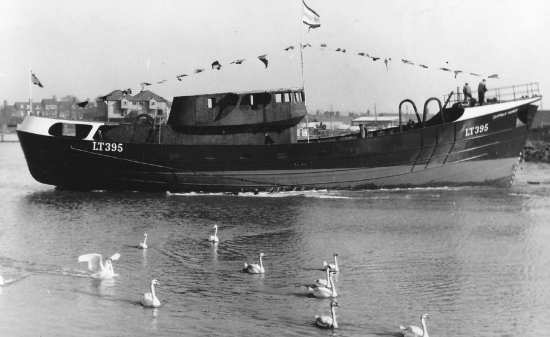
Picture 1 : The Suffolk Punch on the day she was launched. Notice how high she is out of the water. This is because she was the bare skeleton of the hull, just enough to make her float. The engine, masts, winches and other gear would have been fitted whilst she was moored to the quayside. Courtesy of the Port of Lowestoft Research Society.
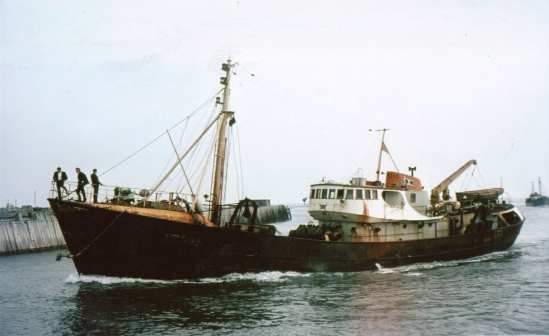
Picture 2 : Suffolk Punch coming into Lowestoft after a fishing trip in the 1960s. Notice how the crew on the bows are dressed in suits. This is because as soon as the ship was docked they would go out to the pubs and clubs to see their wives and friends. Courtesy of the Port of Lowestoft Research Society.
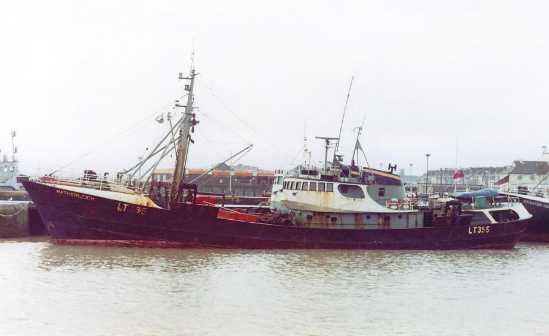
Picture 3 : Hatherleigh as owned by Putford Enterprises Ltd. Photo taken 22nd March 1981.
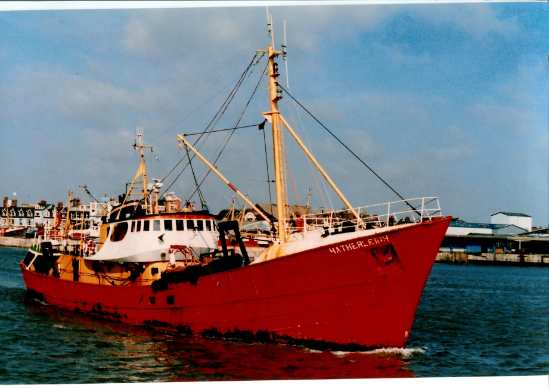
Picture 4 : Hatherleigh working as a service support vessel, 1983-1993. Photograph courtesy of Port of Lowestoft Research Society.
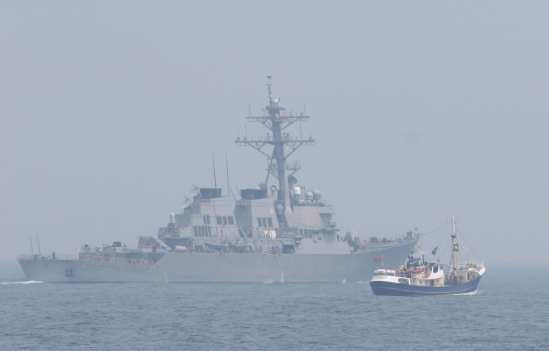
Picture 5 : Hatherleigh dwarfed by U.S. Navy Ship HFTS Barry during the Russian Boarding Exercise.
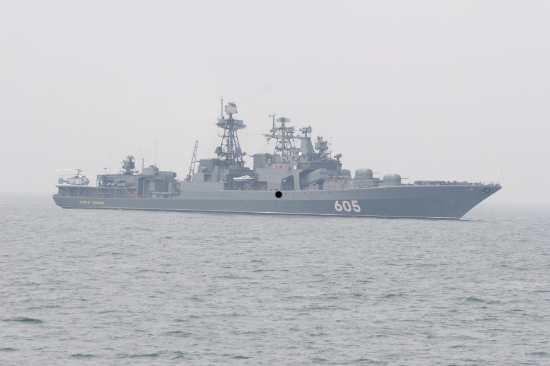
Picture 6 : Russian Navy ship involved in the training exercise Admiral Chenkov. Courtesy of Terry Bunker.
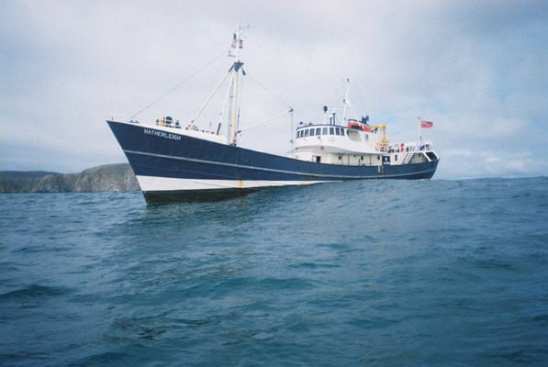
Picture 7 : Hatherleigh off Fair Isle, 2012 Scarborough Sub-Aqua Club Northern Isles Expedition.
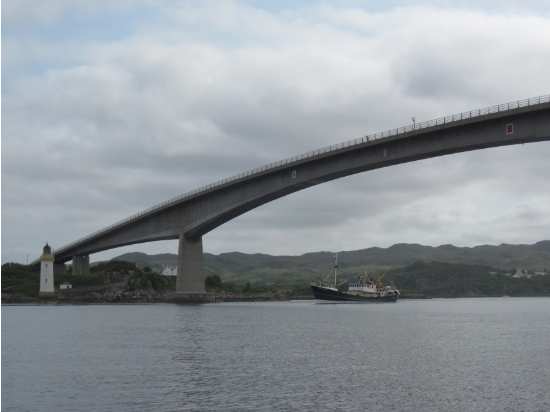
Picture 8 : Hatherleigh sailing under Skye Bridge during the 2013 Scarborough Sub-Aqua Club St. Kilda Expedition. Courtesy of A. Polkey.
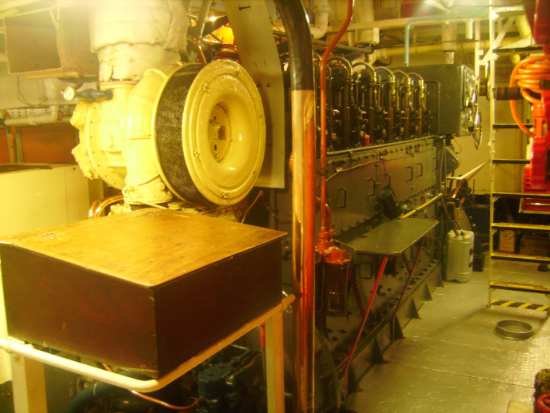
Picture 9 : Hatherleigh's engine (room), port side looking aft.
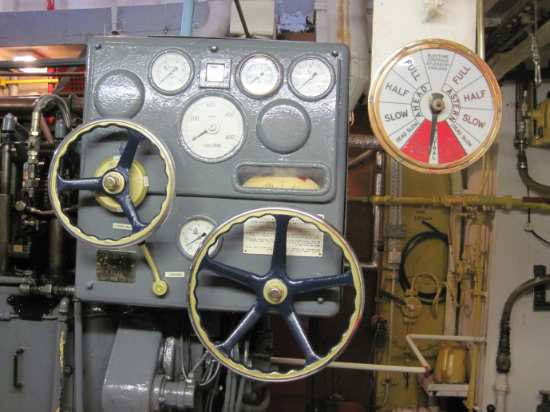
Picture 10 : Hatherleigh's engine control panel. Courtesy of the owner.
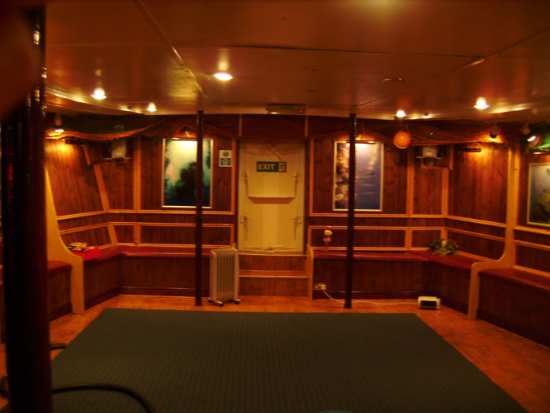
Picture 11 : Hatherleigh's fish hold now converted to bar looking forward. Inset: Bar area
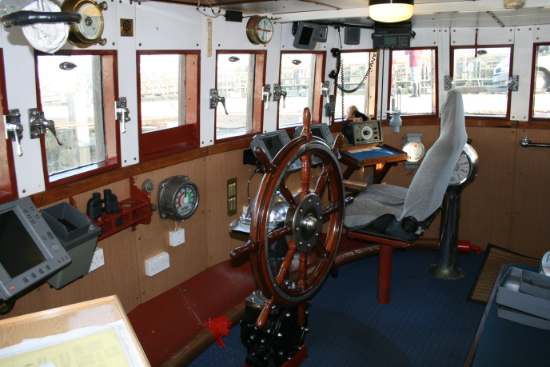
Picture 12 : Hatherleigh's bridge. Notice the original telegraph behind the seat; a feature no modern vessels have any more. Nowadays it’s a simple throttle lever. (courtesy of D.A. Newsome)

Picture 14 : Explorer. The only known steam side-winder trawler left in the world. Photograph taken 2011.

Picture 15 : Arctic Corsair. Hull's side-winder trawler. Photograph taken 2012.